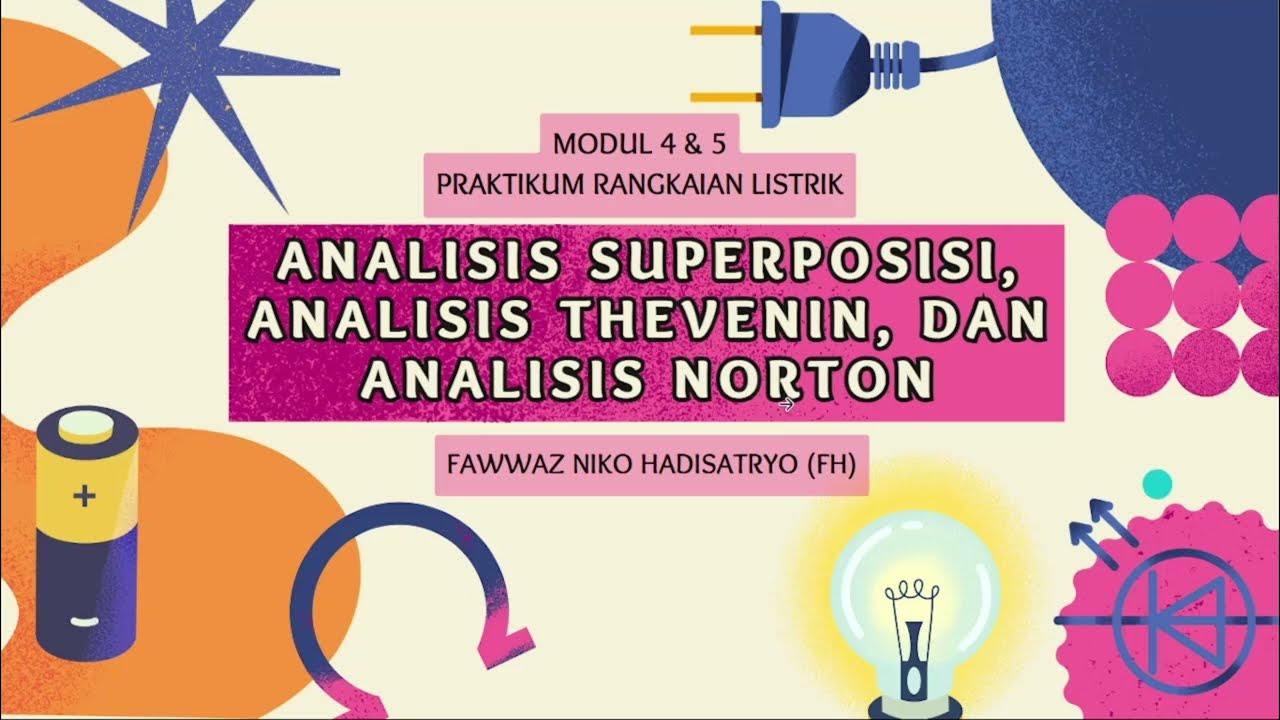Pushing a voltage source through a node
Summary
TLDRThe script discusses the concept of voltage sources in electrical circuits. It explains how voltage sources can be combined and the effect on the circuit when nodes with the same voltage are connected. The video uses Kirchhoff's voltage law to demonstrate that the voltage between two nodes connected by a wire remains unchanged, emphasizing the importance of understanding these principles for analyzing complex circuits.
Takeaways
- 🔌 The script discusses the concept of voltage sources and their relation to circuits.
- 🌐 It explains that by using a voltage source, one can easily understand the characteristics of certain types of circuits.
- 🔗 The concept of a node in a circuit is introduced, where many branches are connected.
- 🔢 It describes a hypothetical scenario with 'N' branches connected to a node, with 'N-1' having the same voltage.
- 🔋 The voltage source is likened to a node that is connected to other nodes in the circuit, all with the same voltage 'V'.
- 🔄 The script uses Kirchhoff's voltage law to explain the voltage between a node and a reference node.
- 🔵 It illustrates how connecting nodes with the same voltage does not affect the circuit's voltage or current.
- 🔗 The script provides an example of connecting resistors in a circuit with a voltage source.
- 🔍 It discusses the concept of a reference node and how it simplifies the analysis of voltage in a circuit.
- 🔗 The idea that nodes with the same voltage can be connected together without changing the circuit's behavior is emphasized.
- 📚 The script concludes by stating that understanding these concepts is useful for analyzing various types of circuits and their characteristics.
Q & A
What is the main concept discussed in the script?
-The script discusses the concept of voltage sources and their behavior in electrical circuits, particularly how they can be simplified and analyzed using Kirchhoff's voltage law.
What does the term 'Thyristor' refer to in the context of the script?
-The term 'Thyristor' is not directly mentioned in the provided script. It seems there might be a confusion or mistranslation. The script talks about voltage sources and circuits, not thyristors.
How are voltage sources represented in the script?
-Voltage sources are represented as nodes with specific voltage values, V, and are connected to other nodes in the circuit through branches.
What is the significance of the node mentioned in the script?
-The node mentioned in the script is significant because it is the reference point for measuring voltages in the circuit and it helps in understanding the distribution of voltage across the circuit.
What is the meaning of 'Vn' in the script?
-In the script, 'Vn' refers to the voltage at a specific node in the circuit, which is being analyzed.
How does the script explain the concept of voltage drops across resistors?
-The script explains that voltage drops across resistors can be calculated using Ohm's law, which is V = IR, where V is voltage, I is current, and R is resistance.
What is Kirchhoff's voltage law as mentioned in the script?
-Kirchhoff's voltage law, as mentioned in the script, states that the sum of the voltages in a closed loop of a circuit is zero, which is used to analyze the voltage across different nodes in a circuit.
What is the practical application of the concepts discussed in the script?
-The concepts discussed in the script are practically applied in analyzing and understanding the behavior of electrical circuits, which is crucial for designing and troubleshooting various electrical systems.
How does the script suggest simplifying complex circuits?
-The script suggests simplifying complex circuits by treating nodes with the same voltage as a single node, thus reducing the complexity of the circuit for easier analysis.
What is the importance of understanding the voltage distribution in a circuit?
-Understanding the voltage distribution in a circuit is important for determining the performance of the circuit, ensuring the correct operation of electronic devices, and for energy efficiency.
Can the script's discussion on voltage sources be applied to real-world electrical systems?
-Yes, the principles discussed in the script regarding voltage sources and circuits are fundamental to the operation of real-world electrical systems, from simple household circuits to complex power distribution networks.
Outlines

Esta sección está disponible solo para usuarios con suscripción. Por favor, mejora tu plan para acceder a esta parte.
Mejorar ahoraMindmap

Esta sección está disponible solo para usuarios con suscripción. Por favor, mejora tu plan para acceder a esta parte.
Mejorar ahoraKeywords

Esta sección está disponible solo para usuarios con suscripción. Por favor, mejora tu plan para acceder a esta parte.
Mejorar ahoraHighlights

Esta sección está disponible solo para usuarios con suscripción. Por favor, mejora tu plan para acceder a esta parte.
Mejorar ahoraTranscripts

Esta sección está disponible solo para usuarios con suscripción. Por favor, mejora tu plan para acceder a esta parte.
Mejorar ahoraVer Más Videos Relacionados

Superposition Theorem (with example)(Unit 1 DC circuits) BEE

Electrical Engineering: Basic Laws (9 of 31) Kirchhoff's Laws: A Simple Example

Video Pembelajaran Modul 4 & 5 Praktikum Rangkaian Listrik 2024/2025 (FH)

W3_L4_The Sinusoid

Semiconductors L12: Diode as a Rectifier | Full-wave, Half Wave & Bridge Rectifiers | Endgame

ejemplo superposición c a
5.0 / 5 (0 votes)
